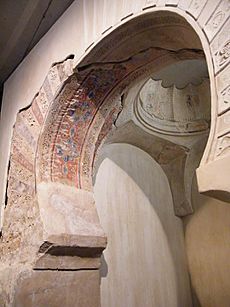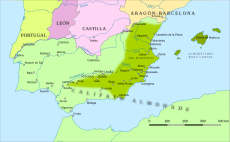Abū ʿAbd Allāh Muḥammad ibn Saʿd ibn Mardanīsh facts for kids

Abū ʿAbd Allāh Muḥammad ibn Saʿd ibn Muḥammad ibn Aḥmad ibn Mardanīsh was a powerful ruler in Al-Andalus (Islamic Spain). He was born around 1124 or 1125 and died in 1172. From 1147 until his death, he was the king of Murcia.
Ibn Mardanīsh built his kingdom around the important cities of Murcia, Valencia, and Dénia. This happened as the power of the Almoravid emirate was fading away. He strongly opposed the growing influence of the Almohad caliphate, another powerful Islamic group. Christian people at the time called him the "Wolf King" (rex Lupus in Latin), which showed how strong and fierce he was seen to be.
Contents
Who Was Ibn Mardanīsh?
Ibn Mardanīsh's full name was very long, as was common for leaders back then. He was known as al-Juḍāmī or at-Tuȳībī. His family name, Mardanīsh, was not Arabic. It likely came from a local Iberian name. This suggests his family were muwallads. This means they were descendants of native Iberian people who had converted to Islam. Some historians think the name Mardanīsh might be linked to an old river name, Merdanix. This river was near the border between Christian and Islamic lands.
His Early Challenges
When Ibn Mardanīsh first became ruler in 1147, he faced a challenge. A relative named Yūsuf ibn Hilāl started a rebellion. Yūsuf took over some castles, including Moratalla. He even defeated Ibn Mardanīsh in a battle.
However, Ibn Mardanīsh managed to capture Yūsuf. He tried to make Yūsuf surrender Moratalla. Yūsuf refused to give up the castle. He was punished and later died in 1148 or 1149. This showed Ibn Mardanīsh's strong will to keep control of his lands.
Making Peace and Trade Deals
Ibn Mardanīsh was also smart about making agreements. In June 1149, he signed a ten-year peace agreement with the republic of Genoa. Genoa was a powerful trading city. In this deal, Ibn Mardanīsh agreed to pay a large sum of money. He also allowed Genoese traders to set up special trading posts, called funduqs, in Valencia and Dénia. He also removed taxes for them. This helped trade grow in his kingdom.
Later, in January 1150, he made a similar agreement with the republic of Pisa. Pisa was another important trading city. This treaty also allowed Pisan merchants to trade safely. It also let them set up their own trading posts. These agreements helped his kingdom become richer through trade.
Facing the Almohads
Ibn Mardanīsh spent much of his rule fighting against the Almohad caliphate. The Almohads were trying to expand their control in Al-Andalus. In 1165, Ibn Mardanīsh led a large army from Murcia. They went to defend the city of Lorca from an Almohad attack.
His army met the Almohad forces in the valley of the Guadalentín river. In the battle that followed, his troops were defeated. This was a significant loss for Ibn Mardanīsh. Despite this, he continued to be a strong opponent of the Almohads until his death.
Sources
- Bosch-Vilá, J. (1971). "Ibn Mardanīsh". The Encyclopaedia of Islam, New Edition, Volume III: H–Iram. Leiden: E. J. Brill. 864–865.
See also
 In Spanish: Muhámmad ibn Mardanís para niños
In Spanish: Muhámmad ibn Mardanís para niños


